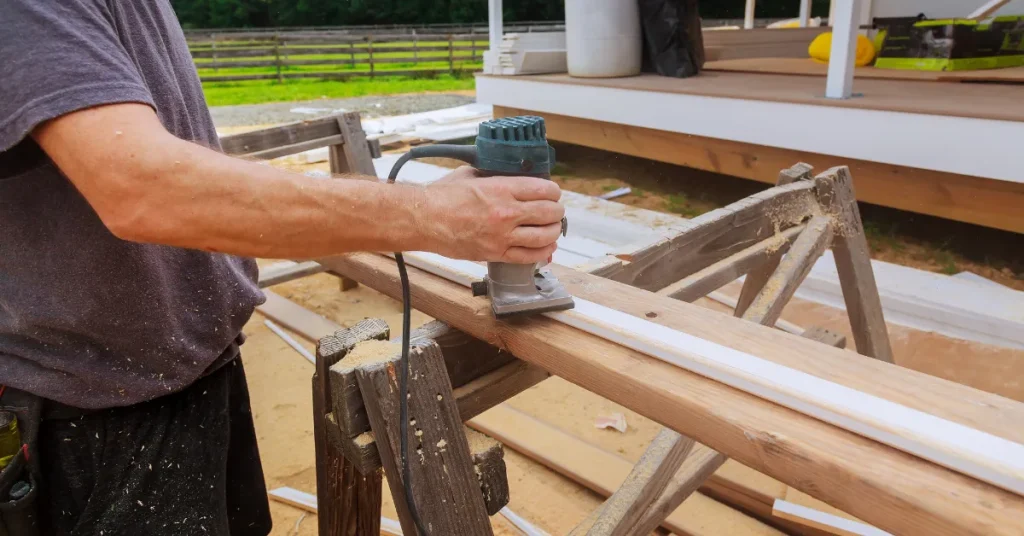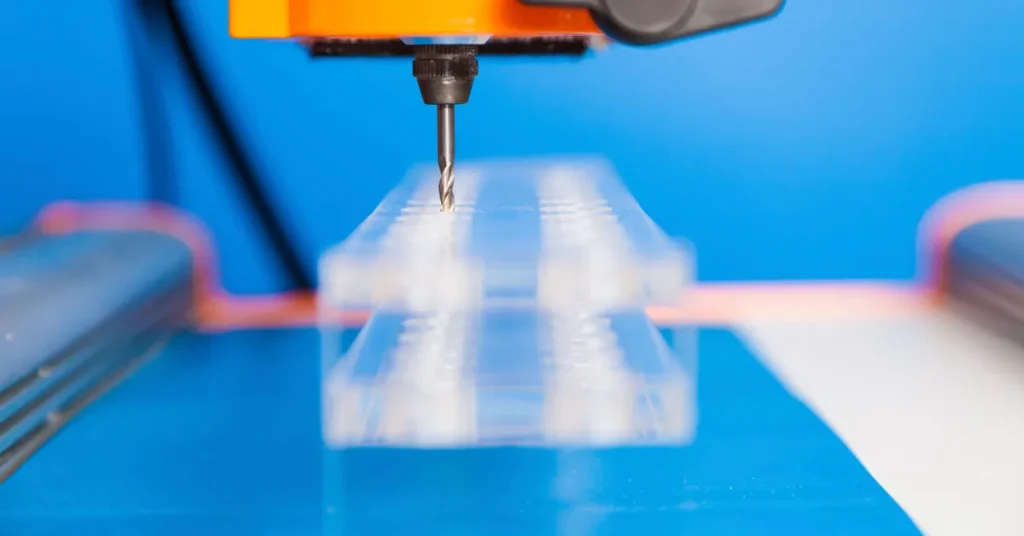A router can typically cut to depths of about one inch. The cutting depth can vary by model and application.
Selecting the appropriate cutting tool is crucial for any woodworking project, and when it comes to routers, understanding their capabilities is essential.
A router is a versatile tool, widely used for tasks ranging from edge shaping to decorative molding. Woodworkers often rely on routers for precise cuts, grooves, and hollows in their material.
The cutting depth of a router, which generally maxes out around one inch, depends on factors including the router’s power, the type of bit used, and the router’s design.
It’s important for users to match the depth capability with the project requirements to ensure quality results and to maintain safety during operation.
By choosing the right router and bit, craftsmen can achieve a variety of cuts with efficiency and accuracy.

Introduction To Router Capabilities
Understanding the true potential of a router begins with exploring its capabilities. A router, often an unsung hero in woodworking, brings a level of flexibility and finesse to projects.
This high-powered tool has a spinning cutter that shapes, hollows out, and creates intricate edges on wood. To comprehend its abilities, it is crucial to delve into how deep a router can cut, which directly reflects on its productivity and application range.
Exploring The Tool’s Versatility
Routers show remarkable versatility in woodworking. With the right bit and settings, routers adeptly perform tasks like:
- Trimming and shaping edges
- Crafting joinery such as dovetails
- Engraving designs
- Hollowing out wood for inlays and mortises
Their adaptable nature allows for working on a variety of materials beyond wood, including plastic and metal laminates.
Factors Influencing Cutting Depth
Several factors impact how deep a router can cut:
- The type of router: Fixed-base routers differ from plunge routers.
- The bit used: Bits come in various shapes and sizes.
- Material hardness: Softer woods cut differently compared to hardwoods.
- Speed settings: Adjusting the router’s speed can affect the depth of the cut.
Typically, routers have an adjustable depth stop that limits how deep the bit goes.
| Router Type | Max Cutting Depth |
| Fixed-Base Router | 1-2 inches depending on the bit |
| Plunge Router | Up to 3 inches with appropriate bit |
Router bits also define the maximum cutting depth. Bits designed for deep cuts feature longer shanks, making them suitable for thick materials or multiple passes.
Router Bit Profiles And Depths

Ever wondered how deep your router can dive into wood? It’s all about the bit. Router bits dictate the path and depth your tool can reach. Let’s explore the sizes and shapes that shape your projects.
For woodworkers, understanding the profiles and depths of router bits unlocks a world of creative possibilities.
Standard Bit Sizes And Their Applications
Standard router bits come in various sizes. They make perfect cuts for everyday projects. These bits craft edges, grooves, and simple profiles with precision.
- 1/4-inch bit: Great for detail work and intricate designs.
- 1/2-inch bit: Ideal for stronger, more durable cuts.
For most tasks, these sizes are your go-to tools. They help create common joints, grooves, and edge profiles.
| Bit Size | Application | Max Depth |
| 1/4-inch | Detail work | 1/2 inch |
| 1/2-inch | General projects | 3/4 inch |
Specialty Bits For Deeper Cuts
Specialty bits dive deeper for those tough jobs. They take routing to the next level, crafting deep profiles and large grooves.
- Mortising bits: Designed for deep, square-bottomed cuts.
- Rabbeting bits: Excel at deep, wide cuts for joinery.
- Cove bits: Produce deep, curvaceous grooves for bold designs.
These specialized soldiers are perfect for dynamic cuts that go beyond the surface. It’s important to match the bit to the task for optimal results.
| Bit Type | Application | Max Depth |
| Mortising | Joinery | Over 1 inch |
| Rabbeting | Large joints | Up to 1 inch |
| Cove | Decorative grooves | Variable |
Remember, going deep requires a steady pace. Pushing too hard can harm both the bit and the wood.
Router Types And Maximum Depths
Woodworkers love routers for their versatility and precision. But one key question is: how deep can these tools cut? The answer lies in the type of router and its design. This section explores the depth capabilities of various routers.
Plunge Routers Versus Fixed-base Routers
Knowing the difference between plunge and fixed-base routers is key to understanding their cutting abilities. A plunge router allows the bit to plunge into the wood, adjusting the depth as it goes.
A fixed-base router has a preset depth that remains constant during the cut. Generally, plunge routers offer more versatility with depth settings.
| Router Type | Max Depth Capability |
| Plunge Router | Up to 3 inches |
| Fixed-Base Router | Up to 2 inches |
Industrial Routers And Their Extended Range
Industrial routers take cutting depths to the next level. These powerhouses are designed for heavy-duty tasks. With deeper cutting abilities, industrial routers can handle thicker materials with ease. Here’s a quick look at their depth capabilities:
- CNC Routers: Up to 10 inches depending on the model
- Production Routers: Generally 2 to 4 inches with specialized versions going deeper
Each industrial router has a specific range tailored to its intended use. Understanding these limits ensures precise and efficient cutting for all your projects.
Material Considerations
Understanding the material is key to successful routing. Different materials can affect how deep a router can cut. Let’s explore how wood density and tough materials influence routing depth.
Wood Density And Impact On Depth
Wood density plays a big role in routing. Softer woods like pine allow deeper cuts with less effort. Hard woods like oak or maple require more passes. Here’s a quick guide on wood types and their densities:
| Wood Type | Density (lbs/ft³) |
| Pine | 25-35 |
| Oak | 45-50 |
| Maple | 40-45 |
Strategies For Routing Tough Materials
Tough materials need special strategies. Here are some tips for routing:
- Sharp bits: Always use sharp router bits to ensure cleaner cuts.
- Slow speed: Reduce speed to prevent burning the material.
- Multiple passes: Make several shallow passes to reach the desired depth.
Remember, patience and precision are critical when dealing with hard materials.
Depth Limitations And Safety Precautions
Understanding depth limitations and safety precautions is critical when working with a router.
Overextending a router’s depth can lead to poor results and risky situations. Ensuring you know the limits and how to protect yourself will result in a smooth, safe woodworking experience.
Recognizing The Signs Of Over-extension
Recognizing over-extension signs is vital. Here are key indicators:
- Excessive vibration during operation
- Unusual noises from the router
- Difficulty in maneuvering the tool
- Burn marks or chipping on the wood
If any of these signs emerge, stop immediately. Adjust the router to a shallower depth and proceed with caution.
Safeguarding Against Router Kickback
Kickback can occur when a router bit is pushed too deep, too fast. Follow these steps to prevent it:
- Secure the wood piece tightly.
- Use sharp, appropriate router bits.
- Set a depth that’s manageable for your material.
- Advance the router slowly and steadily.
- Wear safety equipment, like goggles and ear protection.
By following these precautions, you maintain control and minimize risks.
Techniques For Maximizing Cut Depth

Understanding the ideal cut depth of a router can be tricky, yet essential for woodworking precision. Routers have limits based on their design and bit size. Pushing a router too deep too fast can damage tools and materials. Learn to maximize cut depth effectively.
Multi-pass Routing Strategies
When tackling deep cuts, patience pays off. Incremental steps are key to success. Here’s how:
- Set an initial depth less than the full required cut.
- Gradually increase depth on subsequent passes.
- Multiple shallow passes prevent bit breakage and ensure clean cuts.
- Use a step gauge to maintain consistent depth adjustments.
- Avoid forcing the router, let the tool do the work.
Using Jigs And Templates For Consistency
Jigs and templates contribute to uniformity and depth control:
- Create a template matching the final depth and shape.
- Attach the jig or template securely to guide the router.
- It maintains consistent depth and profile throughout the cut.
Custom jigs can be made to suit specific projects. Templates can be reused for repeating exact cuts on multiple pieces.
FAQs About On How Deep Can A Router Cut
What Is A Router’s Maximum Cutting Depth?
A router’s maximum cutting depth varies by model but typically ranges between 0 to 2. 5 inches. High-power routers can occasionally cut deeper. It’s essential to consult the tool’s specifications for exact capabilities.
How Does A Router Bit Affect Cutting Depth?
The cutting depth capacity of a router is partly determined by the length of the router bit used. Longer bits enable deeper cuts, though they may require multiple passes and adjustments to achieve the desired depth safely.
Can Router Depth Be Adjusted?
Yes, router depth can be adjusted. Most routers feature a depth adjustment mechanism that allows for precise control of the bit position, enabling users to set the desired cutting depth according to the project’s requirements.
Is Maximum Cutting Depth Same For All Materials?
No, the maximum cutting depth isn’t the same for all materials. Tougher materials require shallower passes to maintain accuracy and prevent damage to the router bit, whereas softer materials may allow for deeper cuts in a single pass.
Conclusion
Understanding your router’s capabilities is key for any woodworking project. Precise depths vary, with factors like bit sharpness and material hardness at play.
Always refer to your router’s manual and experiment to ensure perfect cuts. Remember, safety first and happy routing!
Resources:
1. https://www.osha.gov/etools/woodworking/production/machines-tools/routers
